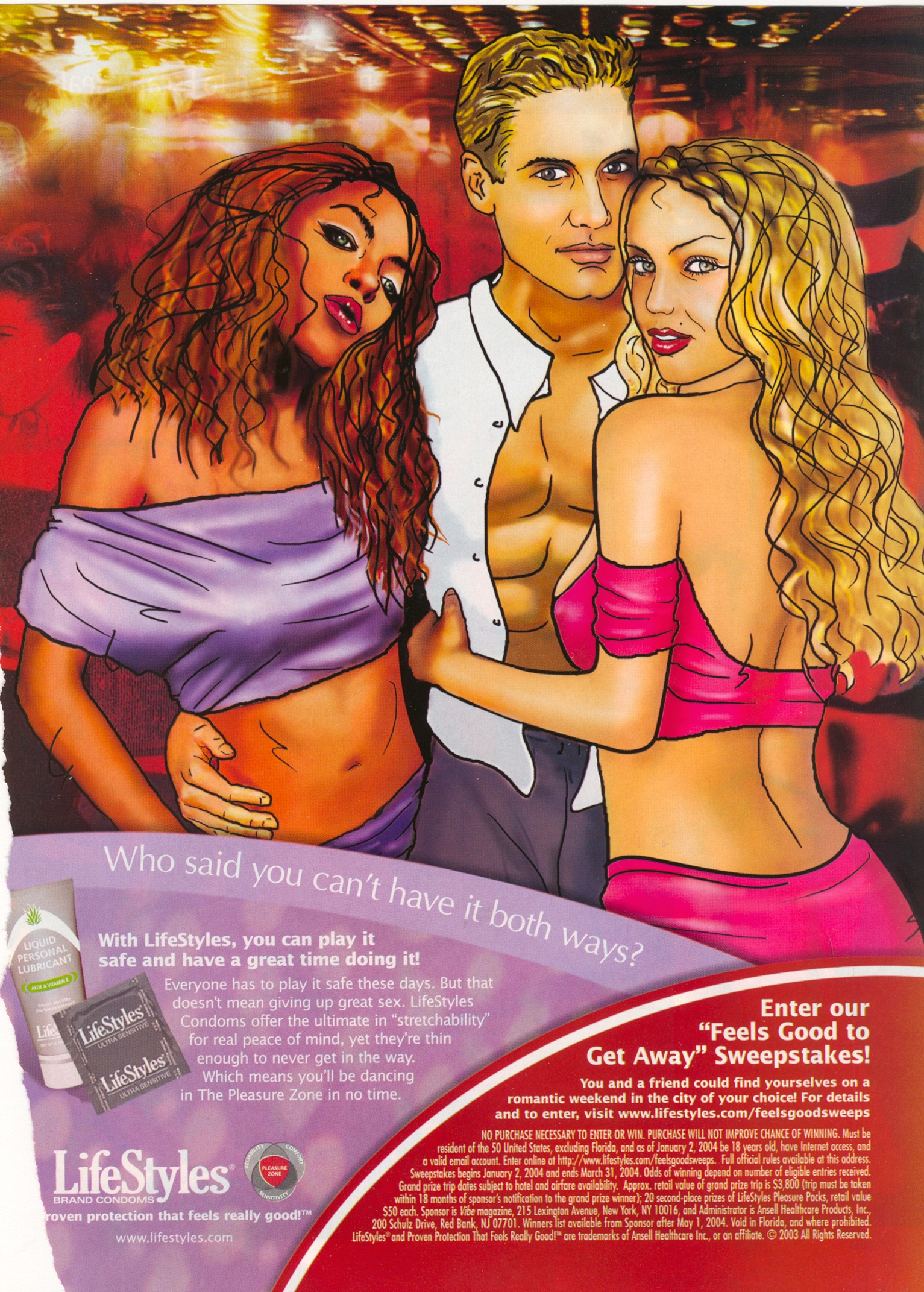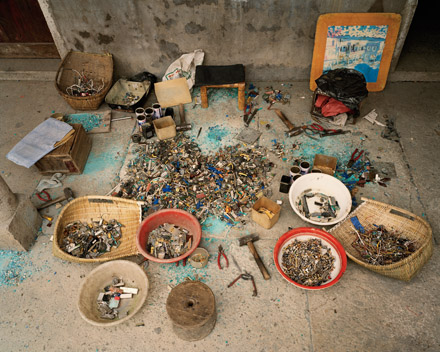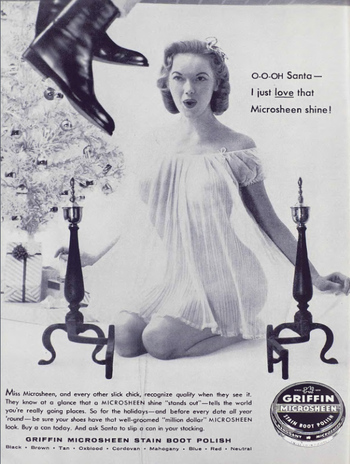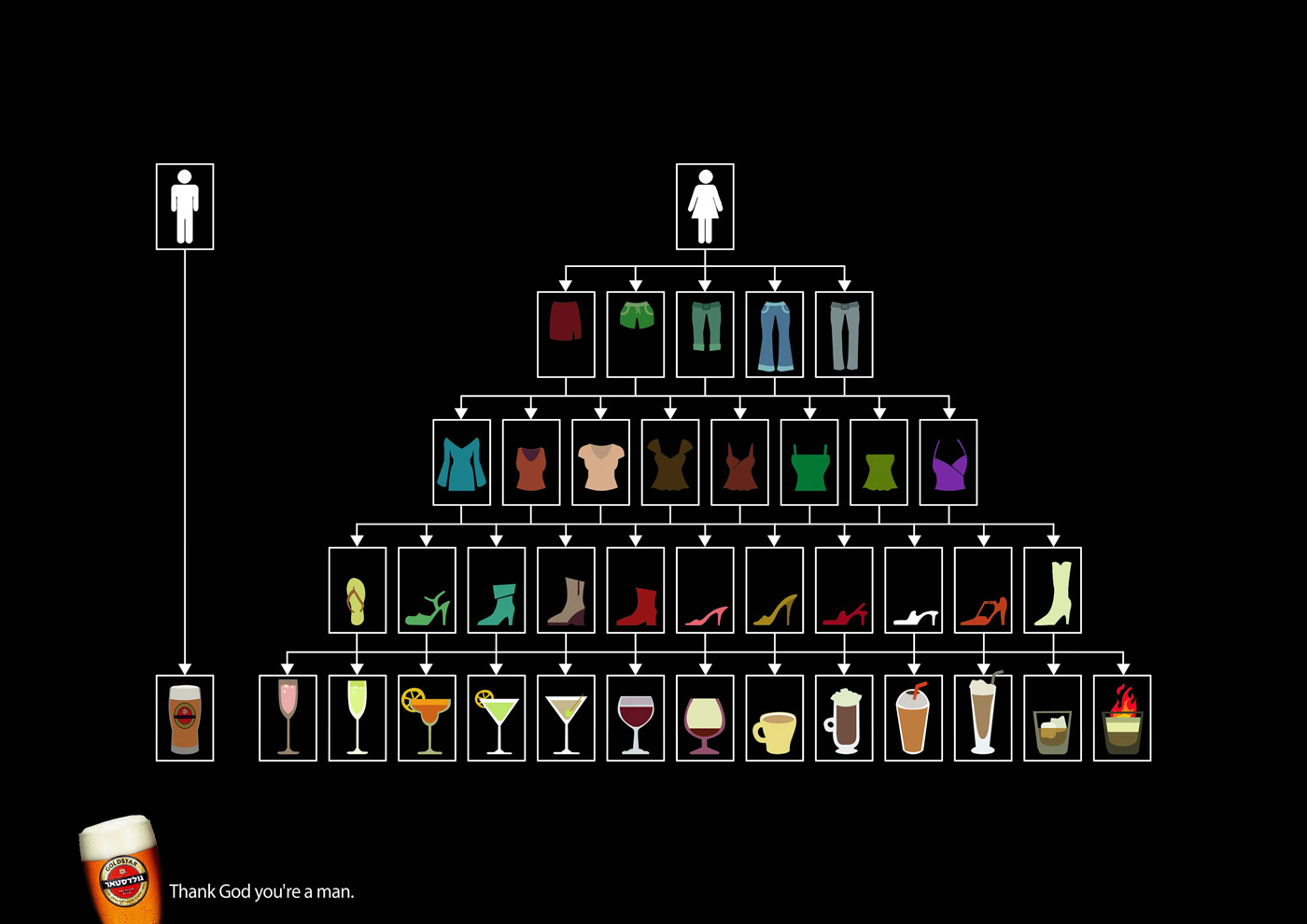In this ad, the copy, which reads “Who said you can’t have it both ways,” refers explicitly to both “play[ing] it safe” with condoms and having “a great time” with “great sex.” Of course, implicitly, it also means not choosing between black and white women. Women are, in the subtext, objects to “have” and black and white women are very different kinds of objects. 
Ben O. brought our attention to a series of sexist ads for Griffen Microsheen boot polish. Here’s one for your Christmas viewing pleasure:
I’m sure Santa was pleased that he could see her nipples through her nightie.
Lots more Microsheen ads at Found in Mom’s Basement.
Thanks, Ben!
Eva M. sent in an image (found here) of a Beauty Smile Trainer:
Presumably you’re supposed to wear it regularly to train yourself to smile the big, wide smiles needed to win beauty contests. It’s another example of how we no longer think of beauty as something “natural,” but rather as something that you get through products, training, and, if necessary, surgery. I guess you can wear this along with your teeth-whitening treatments to get the perfect smile.
Thanks, Eva M.!
In The Gendered Society, Michael Kimmel argues that women often have to be very careful how they dress, lest they be seen as too frumpy, too old, too slutty, too smart, trying to hard, etc. In comparison, men can often just go as a guy.
Two examples:
Nancy: The invitation says black tie, I guess you’ll wear your tux?
Frank: Yup.
Nancy: Mr. Easy. Once choice, one look. I have to ponder endless combinations of hair, makeup, gowns, shoes, jewelry. I have to decide if I want to look sultry, subdued, glittery, basic, bright, dark, modern, traditional…
Frank: Hon, who do you want to please?
Nancy: You, of course.
Frank: I stopped listening after “sultry.” There, Mr. Easy to the rescue.
Nancy: Gee, thanks. Sultry’s the hardest one.
The fact that women can’t just be a “person” at the bar or the black tie event is related to the fact that women are a marked category, while men are culturally neutral. That is, women are women and men are people. For more posts on this idea related to gender and other categories, see this post on toys for kids and our post on that famous real bodies exhibit.
(I found the first image here; the LuAnn cartoon was given to me by Myra M. F.)
In a previous post, I shared some photographs by Edward Burtynsky of oil fields and mines. Burtynsky takes pictures with an eye towards the modern global economy. This set documents massive piles of waste sorted for recycling:
Three pictures of the Oxford tire pile in Westley, California (1999):
Densified Oil Drums in Hamilton, Ontario (1997):
Metal for recycling in Hamilton, Ontario (1997):
Metal for recycling in Hamilton, Ontario (1997):
Plastic toy parts in Guiyu, Guangdong Province (2004):
Circuit boards in Guiyu, Guangdong Province (2004):
Recycling work station (I believe the worker is taking apart computers) in Zenguo, Zhejiang Province (2004):
Stephen W. sent us a link to a Walmart YouTube channel that recreates the supermom mythology. The website encourages moms to submit videos of themselves explaining how they’ve figured out how to save money while shopping, cooking, and cleaning. The website reads:
With creativity, ingenuity, and Walmart’s unbeatable prices. Moms can do anything.
(I bet they can’t coupon us out of this economic crisis though.)
Here’s a screen shot:
My first thought was: So apparently the wife is the one doing all the spending and, if she is a good little wife, she’s frugal and makes her husband’s hard-earned money go further. This would reproduce the husband as money-earner/wife as money-spender stereotype.
But then I realized: There’s no mention a dad or any earner anywhere on the front page. It’s nothin’ but moms.

Aaron B. sent in this 1947 video clip (found here), titled “Are You Popular?”:
Notice the caution to women: if you go “parking with all the boys,” you might think you’re popular, but you’ll ultimately find yourself ostracized and friendless. To be really popular, you need to be well-dressed, have the respect of girls at school, and carefully guard your reputation.
Thanks, Aaron!
Gwen Sharp is an associate professor of sociology at Nevada State College. You can follow her on Twitter at @gwensharpnv.
Robin B. sent us a link to a story in the New York Times magazine chronicling one woman’s decision to have a surrogate carry her biological child. Surrogacy is, from one perspective, extremely expensive and, from another perspective, extremely lucrative. The photos accompanying the story illustrate, almost as if by design, how “mothering” is being spread out in systematic ways to different kinds of women. Robin note that the accompanying article bought up lots of issues, but did little to think them through. In contrast, she points to a set of letters written in response.
Lisa Wade, PhD is an Associate Professor at Tulane University. She is the author of American Hookup, a book about college sexual culture; a textbook about gender; and a forthcoming introductory text: Terrible Magnificent Sociology. You can follow her on Twitter and Instagram.







